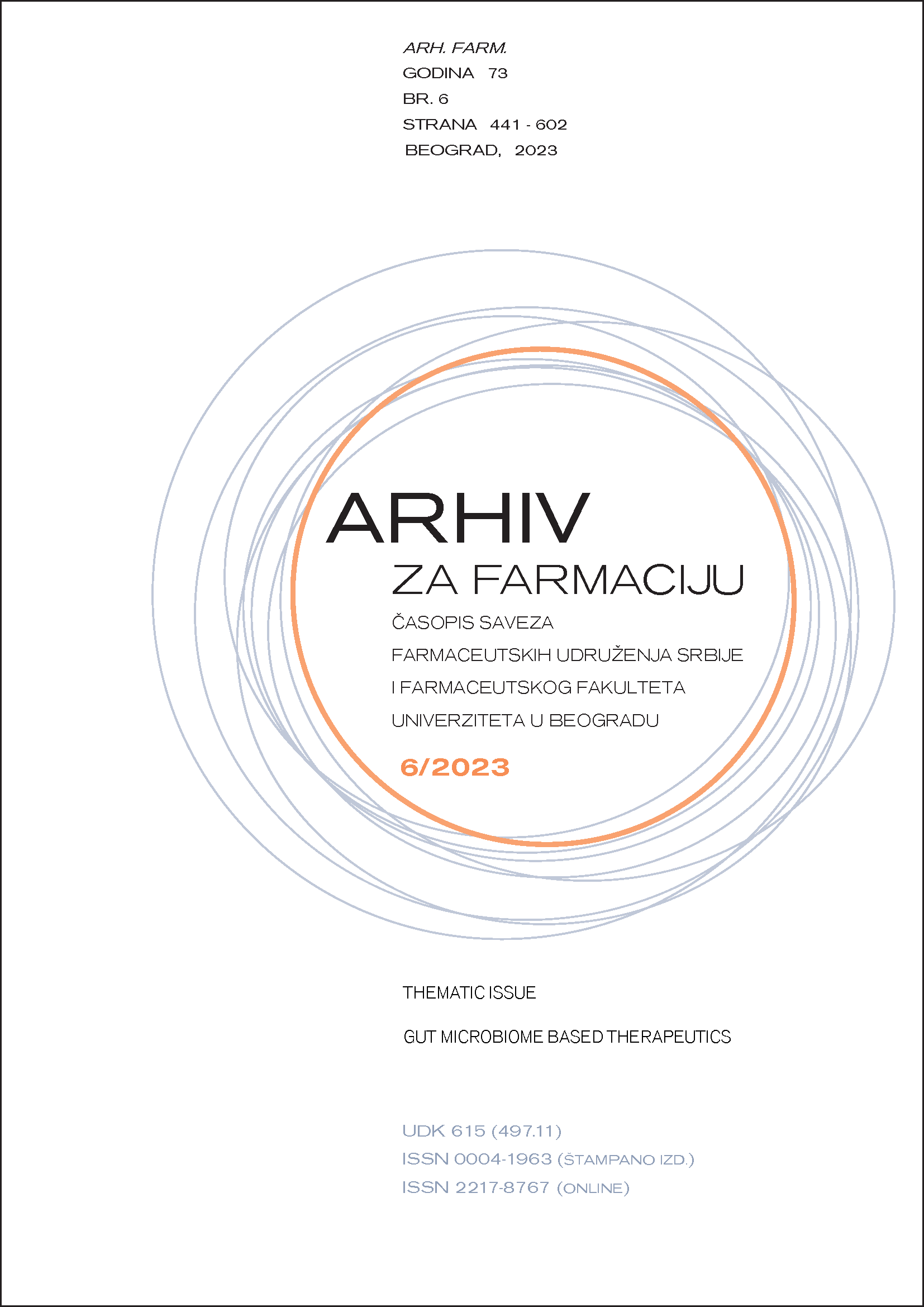Effect of immunostimulating Limosilactobacillus strain in rats with trinitrobenzenesulfonate (TNBS)-induced colitis
Abstract
The aim of the study was to test the potential of immunostimulating Limosilactobacillus fermentum BGHI14 strain to reduce the damage of colon tissue in rats with 2,4,6-trinitrobenzenesulfonic acid (TNBS)-induced colitis. Wistar rats were treated with L. fermentum BGHI14 in the regime of preventive, therapeutic and continuous treatment 22 days prior to and/or 7 days after the administration of TNBS. After sacrifice, the colon tissue samples were taken for RNA isolation, gene expression analysis, histopathological analysis, and malondialdehyde measurement. Judging from the body weights, histopathological scores, malondialdehyde levels and transcription of IL-1β and Tight junction protein 1 (Tjp-1) coding genes, preventive and therapeutic treatment proved to be the most protective in the applied conditions. On the other hand, continuous treatment did not affect the intensity of tissue damage. Considering these results, we discussed the possible mechanisms which might stand behind the protective action of immunostimulating probiotic bacteria in the case of mucosal barrier damage.
References
Jagtap G, Niphadkar V. Protective effect of aqueous extract of Bombax malabaricum DC on experimental models of inflammatory bowel disease in rats and mice. Indian J Exp Biol. 2011;49:343.
Sartor B. Mechanisms of disease: pathogenesis of Crohn’s disease and ulcerative colitis. Nat Clin Pract Gastroenterol Hepatol. 2006;3:390.
Hayee B, Rahman Z, Sewell G, Smith M, Segal W. Crohn’s disease as an immunodeficiency. Expert Rev Clin Immunol. 2010;6:585.
Dithel G, Vasina V, Barbara G, de Ponti F. Animal models of chemically induced intestinal inflammation: predictivity and ethical issues. Pharmacol Ther. 2013;139:71.
Llopis M, Antolín M, Guarner F, Salas, Malagelada R. Mucosal colonization with Lactobacillus casei mitigates barrier injury induced by exposure to trinitrobenzene sulphonic acid. Gut. 2005;54:955.
Guarner F, Malagelada R. Role of bacteria in experimental colitis. Best Pract Res Clin Gastroenterol. 2003;17:793.
Corte C, Saxena P, Tattersall S, Selinger C, Leong RW. When to use biological agents in inflammatory bowel disease. J Gastroenterol Hepatol. 2012;27:1141.
Farnworth R. The evidence to support health claims for probiotics. J Nutr. 2008;138:1250S.
Seksik P, Dray X, Sokol H, Marteau P. Is there any place for alimentary probiotics, prebiotics or synbiotics, for patients with inflammatory bowel disease? Mol Nutr Food Res. 2008;52:906.
Prantera C, Scribano L, Andreoli A, Luyi C. Ineffectiveness of probiotics in preventing recurrence after curative resection for Crohn’s disease - a randomized controlled trial with Lactobacillus GG. Gut. 2002;51:405.
Jiménez E, Langa S, Martín V, Arroyo R, Martín R, Fernández L, et al. Complete genome sequence of Lactobacillus fermentum CECT 5716, a probiotic strain isolated from human milk. J Bacteriol. 2010;192:4800.
Kaewnopparat S, Dangmanee N, Kaewnopparat N, Srichana T, Chulasiri M, Settharaksa S. In vitro probiotic properties of Lactobacillus fermentum SK5 isolated from vagina of a healthy woman. Anaerobe. 2013;22:6.
Mikelsaar M, Zilmer M. Lactobacillus fermentum ME-3 - an antimicrobial and antioxidative probiotic. Microb Ecol Health Dis. 2009;21:1.
Park H, Lee Y, Moon E, Seok H, Cho A, Baek W, et al. Immunoenhancing effects of a new probiotic strain, Lactobacillus fermentum PL9005. J Food Prot. 2005;68:571.
Fazeli R, Hajimohammadali M, Moshkani A, Samadi N, Jamalifar H, Khoshayand R, et al. Aflatoxin B1 binding capacity of autochtonous strains of lactic acid bacteria. J Food Prot. 2009;72:189.
Walter J. Ecological role of lactobacilli in the gastrointestinal tract: implications for fundamental and biomedical research. Appl Environ Microbiol. 2008;74:4985.
Dinić M, Lukić J, Djokić J, Milenković M, Strahinić I, Golić N, et al. Lactobacillus fermentum postbiotic-induced autophagy as potential approach for treatment of acetaminophen hepatotoxicity. Front Microbiol. 2017;8:594.
Dinić M, Herholz M, Kačarević U, Radojević D, Novović K, Đokić J, et al. Host-commensal interaction promotes health and lifespan in Caenorhabditis elegans through the activation of HLH-30/TFEB-mediated autophagy. Aging (Albany NY). 2021;13(6):8040-8054.
Lukic J, Strahinic I, Milenkovic M, Golic N, Kojic M, Topisirovic L, et al. Interaction of Lactobacillus fermentum BGHI14 with rat colonic mucosa: implications for colitis induction. Appl Environ Microbiol. 2013;79:5735.
Chomczynski P, Sacchi N. The single-step method of RNA isolation by acid guanidinium thiocyanate-phenol-chloroform extraction: twenty-something years on. Nat Protoc. 2006;1:581.
McCluskey D, Sava D, Harbison C, Muro-Cacho A, Giffe T, Ping X, et al. Hepatoprotective effects of select water-soluble PARP inhibitors in a carbon tetrachloride model. Int J Crit Illn Inj Sci. 2011;1:97.
Daniel C, Poiret S, Godercourt D, Dennin V, Leyer G, Pot B. Selecting lactic acid bacteria for their safety and functionality by use of a mouse colitis model. Appl Environ Microbiol. 2006;72:5799.
Veljović K, Dinić M, Lukić J, Mihajlović S, Tolinački M, Živković M, et al. Promotion of early gut colonization by probiotic intervention on microbiota diversity in pregnant sows. Front Microbiol. 2017;8:2028.
Golić N, Veljović K, Popović N, Djokić J, Strahinić I, Mrvaljević I, et al. In vitro and in vivo antagonistic activity of new probiotic culture against Clostridium difficile and Clostridium perfringens. BMC Microbiol. 2017;17(1):108.
Bruewer M, Luegering A, Kucharzik T, Parkos A, Madara L, Hopkins M, et al. Proinflammatory cytokines disrupt epithelial barrier function by apoptosis-independent mechanisms. J Immunol. 2003;171:6164.
Rochat T, Bermúdez-Humarán L, Gratadoux J, Fourage C, Hoebler C, Corthier G, et al. Anti-inflammatory effects of Lactobacillus casei BL23 producing or not a manganese-dependant catalase on DSS-induced colitis in mice. Microb Cell Fact. 2007;6:22.
Schepens A, Vink C, Schonewille J, Roelofs M, Brummer J, van der Meer R, et al. Supplemental antioxidants do not ameliorate colitis development in HLA-B27 transgenic rats despite extremely low glutathione levels in colonic mucosa. Inflamm Bowel Dis. 2011;17:2065.
Eckmann L, Nebelsiek T, Fingerle A, Dann M, Mages J, Lang R, et al. Opposing functions of IKKβ during acute and chronic intestinal inflammation. Proc Natl Acad Sci U S A. 2008;105:15058.
HuaZhang A, Cheng Q, XueTao C. Regulation of Toll-like receptor signaling in the innate immunity. Sci China Life Sci. 2010;1:34.
Geier S, Butler N, Giffard M, Howarth S. Prebiotic and symbiotic fructooligosaccharide administration fails to reduce the severity of experimental colitis in rats. Dis Colon Rectum. 2007;50:1061.

